In exploring options for hair cleansing, particularly in contexts where hair analysis might be relevant, individuals sometimes come across products like the Toxin Rid Old Style Aloe Shampoo. This product is often discussed as an alternative to harsher, potentially damaging approaches sometimes found online, which may involve substances not intended for cosmetic use.
This review examines Toxin Rid Old Style Aloe Shampoo, looking into information about its formulation, the science surrounding hair cleansing ingredients, and how it’s typically used. The goal is to provide a clear understanding of the product within the framework of responsible use, hair health, and the important legal and ethical considerations surrounding hair follicle analysis.
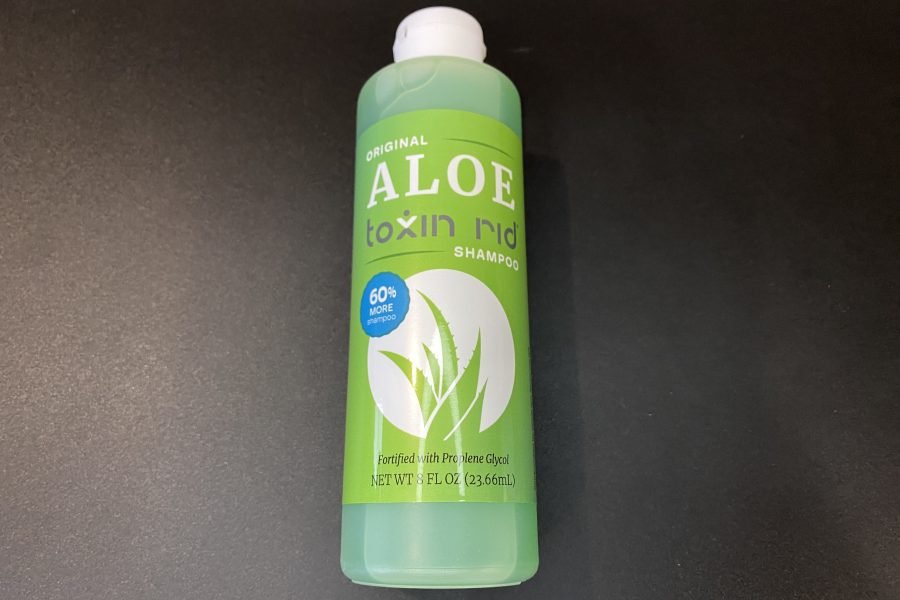
Quick summary
So, what’s the perspective on Toxin Rid Old Style Aloe Shampoo? It is marketed as a hair cleansing product. Some ingredients, like propylene glycol, have been studied for their potential to reduce the concentration of certain substances (like metabolites of marijuana, alcohol, cocaine, morphine, and methamphetamine) in hair strands.
Its potential effect is based on ingredients common in cosmetic applications and supported by some scientific research, which we’ll delve into. However, it’s crucial to understand the limitations of these studies and the product’s claims.
For individuals with very low levels of exposure or infrequent contact with substances, other cleansing shampoos like Zydot Ultra Clean might be considered, though effectiveness varies widely. Success with any cleansing shampoo often hinges on multiple applications, following instructions carefully, and understanding that no product guarantees a specific outcome in a formal screening process.
We will explore typical usage guidelines later.
Important Disclaimer: This article discusses a commercially available shampoo and related scientific studies. It does not endorse or encourage any activities aimed at interfering with legally mandated or safety-related drug testing. Attempting to alter drug test results can carry significant legal consequences and ethical implications, especially in employment or legal contexts. The only certain way to ensure a hair sample reflects non-use is abstinence from substances. This product is not evaluated by the FDA for the purpose of altering test results.
To understand why products like Aloe Toxin Rid are discussed in relation to hair analysis, let’s first review how hair follicle screening generally works.
Hair drug testing procedure
During a typical hair collection for analysis, a collector will cut approximately 100-120 hairs, usually from the crown area of the head. Samples are typically taken from multiple spots to avoid creating a noticeable thin patch. This method aims for discretion while ensuring enough hair is collected for laboratory analysis.
These hair strands are then packaged securely and sent to a laboratory. Upon arrival, they undergo preparation. Technicians often wash the hair exterior to remove external contaminants before dissolving the hair itself in a chemical solvent. This process releases any substances, including drug metabolites, that may have been incorporated into the hair structure from the bloodstream during growth.
Once dissolved, the resulting liquid solution is analyzed, often using sophisticated techniques like mass spectrometry, to measure the concentration of specific drug metabolites. This quantitative step determines the test outcome. If the concentration of any targeted drug metabolite exceeds predefined cutoff levels established by regulatory bodies or testing guidelines, the result is typically reported as positive. It’s important to note these tests are often used for workplace safety, legal compliance, or medical purposes, underscoring the importance of accurate results.
Evaluating Old Style Aloe Toxin Rid Shampoo in the Context of Hair Analysis
The discussion around shampoos like Old Style Aloe Toxin Rid often involves their ingredients, particularly propylene glycol. Some scientific studies have investigated whether certain cosmetic treatments can affect the concentration of drug metabolites found within hair strands.
Summary of research
One study published in the NIH database explored the potential for various hair treatments to alter drug concentrations in hair samples positive for THC (a marijuana metabolite). Among the tested products was a shampoo containing propylene glycol. The study analyzed 54 THC-positive hair samples. The results indicated a mean reduction of 52% in THC concentration after treatment with the propylene glycol shampoo under laboratory conditions. The study noted that these treatments did not cause visually detectable alterations to the hair.
Limitations: It’s important to note this study used a specific set of samples and laboratory procedures. A 52% mean reduction does not guarantee any specific sample will fall below detection cutoffs, as initial concentrations vary greatly. Real-world factors like hair type, individual metabolism, and usage patterns could lead to different results.
Another research paper available on ResearchGate examined the effect of a different shampoo also containing propylene glycol (Ultra Clean) on hair samples from 14 individuals with known histories of drug use. Hair was analyzed before and after a single washing. While metabolites were still detectable post-wash, concentrations generally decreased. For example, the study reported average decreases of 5% for cocaine, 26% for morphine, and 36% for THC after one wash.
Limitations: This study involved a small sample size (14 individuals) and only tested a single application. The reported reductions, especially for cocaine (5%), are modest and might not be sufficient to alter test outcomes depending on initial levels and testing cutoffs. The variability in results among individuals is also a key factor.
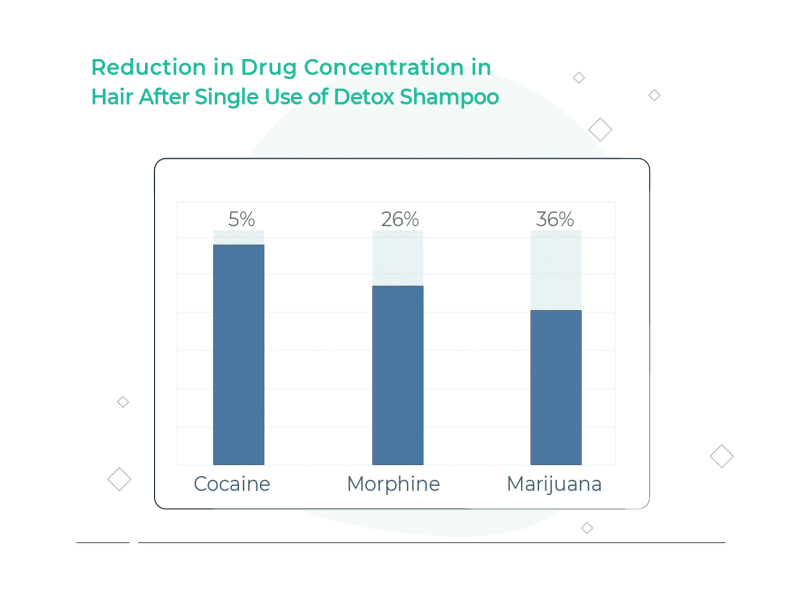
Both studies suggest that shampoos containing propylene glycol may reduce concentrations of certain drug metabolites in hair samples under specific laboratory conditions. However, they do not confirm that products like Old Style Aloe Toxin Rid will reliably or completely remove metabolites to the point of ensuring a negative result in a formal drug screening process.
Considerations Regarding Detox Shampoos and Ethyl Glucuronide (EtG) in Hair
A study available via PubMed investigated the effect of four different commercially available “detox” shampoos on Ethyl Glucuronide (EtG) concentrations in hair. EtG is a direct metabolite of alcohol used as a biomarker for assessing past alcohol consumption, often recommended by organizations like the Society of Hair Testing (SoHT).
The research involved treating hair samples from three individuals with each of the four shampoos. The findings revealed significant variability among the products. One shampoo demonstrated a substantial reduction in EtG levels, decreasing by up to 86% after 2.5 hours of application under lab conditions. The study often attributes such effects to ingredients like propylene glycol, surfactants, or chelating agents present in some formulations.
Conclusion and Application Context
These results suggest that certain hair cleansing products, potentially including those with ingredients like propylene glycol (a component of Toxin Rid Old Style Aloe Shampoo), might reduce EtG concentrations in hair samples in a laboratory setting. This information is relevant for understanding the potential impact of such shampoos on hair analysis results for alcohol consumption markers like EtG, as well as THC and other substances previously discussed.
However, the study also underscores that a single application is often insufficient to cause significant reductions, and the effectiveness varies greatly between products and potentially between individuals. Multiple, consistent applications over time are generally suggested by product instructions or inferred from study findings showing gradual reduction. Later sections will touch upon general usage guidelines based on manufacturer suggestions and user experiences, emphasizing that these are not scientifically validated protocols for guaranteeing specific outcomes.
Ethical and Legal Reminder: While exploring the science of hair cleansing is informative, it’s critical to remember the context. Hair follicle analysis is often used in safety-sensitive employment (pilots, drivers) or legal situations (probation, child custody). Attempting to manipulate these tests can have severe consequences, including job loss, legal penalties, and ethical breaches. Transparency and adherence to legal/workplace requirements are paramount.
How Might Old Style Aloe Toxin Rid Shampoo Interact with Hair?
To understand the proposed mechanism of action for shampoos like Old Style Aloe Toxin Rid, it helps to know a bit about hair structure and how substances become part of the hair.
How Substances Enter Hair
Hair is mainly keratin protein and has three layers:
- Cuticle: The outer, protective layer of overlapping scales.
- Cortex: The main body of the hair shaft, containing keratin fibers and pigment (melanin). This is where most drug metabolites are believed to become trapped.
- Medulla: The innermost core, which isn’t present in all hairs.
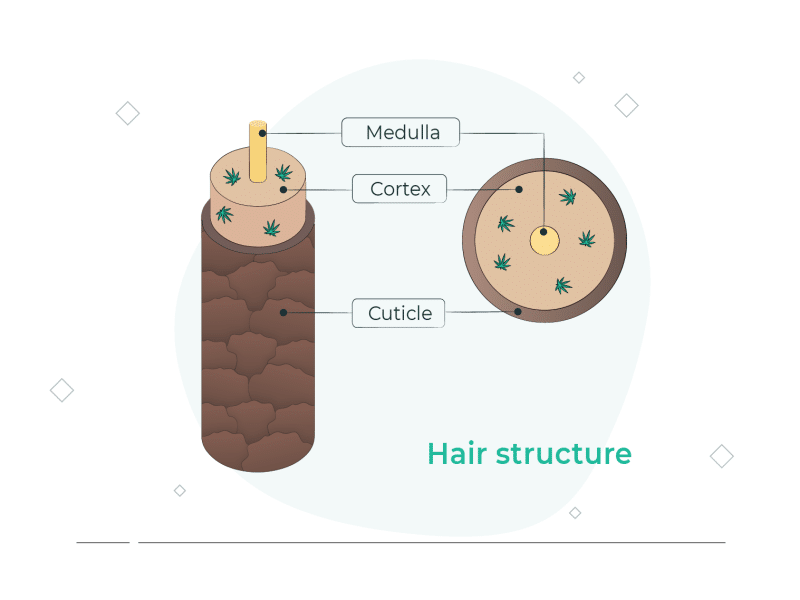
When substances are consumed, they enter the bloodstream. As hair grows from the follicle (rooted beneath the scalp), blood vessels supply nutrients. During this formation process, substances circulating in the blood, including parent drugs and their metabolites, can be incorporated into the keratin matrix, primarily within the cortex. Once embedded in the hair shaft and as the hair grows out, these substances remain relatively stable, creating a historical record of exposure.
The Claimed Mechanism of Old Style Aloe Toxin Rid Shampoo
Products like this shampoo are designed with the aim of reducing the concentration of these embedded substances. The theories behind how they might work often involve two aspects:
- Interaction with Hair Structure: Certain ingredients, like propylene glycol, are known penetration enhancers in cosmetics. The claim is that such ingredients might help the shampoo penetrate the hair cuticle and interact with the cortex, potentially disrupting the bonds holding metabolite molecules within the keratin structure.
- Cleansing and Solubilizing Agents: Surfactants (like Sodium Laureth Sulfate, Sodium Lauryl Sulfate, Cocamide DEA, Cocamidopropyl Betaine) are cleansing agents designed to lift away oils and residues. The formulation might also include ingredients intended to help dissolve or solubilize the released metabolites, making them easier to rinse away with water.
Essentially, the idea is that the shampoo works not just on the surface but attempts to access the hair’s cortex to dislodge and wash away embedded metabolites. However, the actual effectiveness and extent of this process in real-world scenarios are complex and not fully guaranteed by scientific evidence. The hair matrix is robust, and completely removing deeply embedded compounds is challenging.
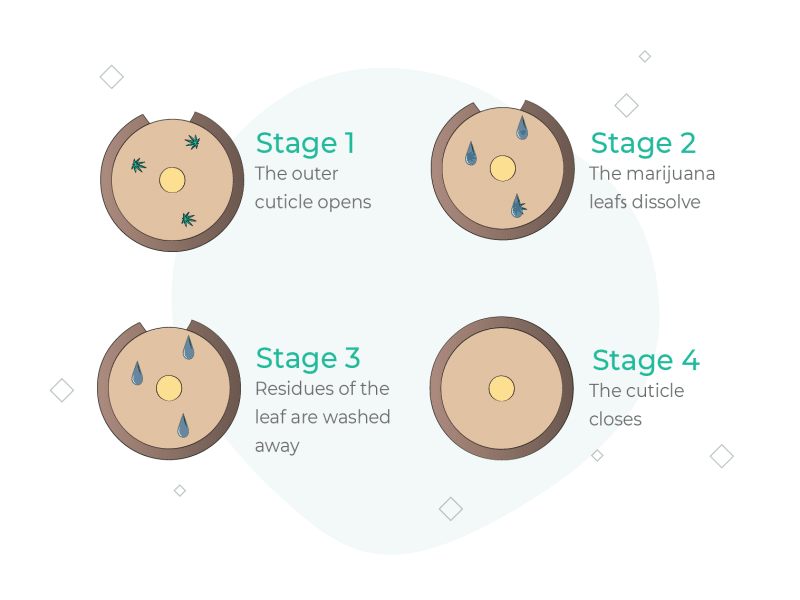
Does Hair Type Influence Cleansing Outcomes?
Individual hair characteristics can indeed play a role in how substances bind to hair and potentially influence the effectiveness of any cleansing or treatment process.
Hair Characteristics That May Affect Metabolite Retention:
The structure and properties of hair can impact how easily substances are incorporated and how challenging they might be to remove.
- Thicker Hair: A larger cortex diameter might offer more volume for metabolites to become embedded.
- Dense Hair: Higher hair density (more strands per area) means more total hair mass available for substance incorporation.
- Low Porosity Hair: Hair with tightly sealed cuticles resists moisture and potentially the penetration of treatment products.
- Darker Hair: Higher melanin content in darker hair has been suggested in some research to bind more strongly with certain drug compounds.
- Hair Condition: Hair that is less damaged or chemically treated often has a more intact cuticle layer, potentially making it more resistant to penetration compared to porous, damaged hair.
- Hair Age/Length: The portion of hair furthest from the scalp is older and has had longer environmental exposure, which might affect its structure and interaction with treatments.
These factors contribute to the variability often seen in hair analysis results and could influence how effective any cleansing shampoo might be for a particular individual.
Variability in Substance Reduction
Studies examining the effects of washing or treatments on drug metabolite concentrations in hair have shown different results depending on the substance. For instance, the research mentioned earlier indicated varying percentage reductions for THC, morphine, methamphetamine, and cocaine after treatment with propylene glycol-containing shampoos under specific lab conditions. Substances that bind more tightly or are present in higher initial concentrations would logically require a greater reduction to potentially fall below laboratory cutoffs, and cleansing products may not consistently achieve this. It is inaccurate to claim universal effectiveness across all substances or for all individuals.
Comparing Old Style Aloe Toxin Rid Shampoo to Other Methods
When facing hair analysis, individuals sometimes research various methods online, including aggressive approaches often discussed on forums like Reddit, sometimes referred to by names like the Macujo or Jerry G methods. It’s crucial to understand the significant differences and risks involved.
Aggressive Chemical Methods
These typically involve applying harsh chemicals not intended for cosmetic use directly to the hair and scalp. Common ingredients mentioned in these DIY methods include potent household cleaners, industrial solvents, acids (like vinegar used in high concentrations or stronger acids), bases, or oxidizing agents (like hair bleach).
Effectiveness: While some potent chemicals, particularly bleach, have been shown in studies (like one noted by NIH) to degrade certain drug metabolites (like THC) in hair strands to some extent, their effectiveness is highly unpredictable and inconsistent. They do not guarantee removal below detection limits.
Severe Risks: The primary concern is safety. These substances can cause severe chemical burns to the scalp, skin irritation, allergic reactions, eye damage, and permanent damage to the hair structure (making it brittle, prone to breakage). The damage is often visually obvious.
Detection and Consequences: Test collectors are trained to look for signs of specimen adulteration or tampering. Obvious hair damage or scalp irritation resulting from these harsh methods can lead to the sample being rejected, flagged for suspicion, or prompting collection from an alternative body site (like body hair). If the test is legally mandated, evidence of tampering can lead to serious legal repercussions. These methods are scientifically unverified for reliable detoxification and carry unacceptable health and legal risks.
Old Style Aloe Toxin Rid Shampoo
In contrast, Old Style Aloe Toxin Rid is a commercially manufactured cosmetic product formulated specifically for use on hair.
Intended Use & Formulation: It uses ingredients common in the cosmetic industry (see Ingredients section) and is designed to cleanse the hair. While it contains propylene glycol, which has been studied for its potential effects on metabolites, it is fundamentally a shampoo.
Damage Potential: Used as directed, it is generally considered less likely to cause the severe, immediate damage associated with harsh chemical mixtures. However, individual sensitivities or overuse could still potentially lead to scalp irritation for some users.
Legality: Purchasing and using a cosmetic shampoo is legal. However, the intent behind its use matters significantly. Using any product specifically to defraud a drug test required by law or for safety-sensitive employment carries potential legal risks and violates ethical standards.
Safety and Side Effects: While generally safer than DIY chemical treatments, reviewing the ingredients is wise, especially for those with known allergies or scalp conditions. Consulting a healthcare provider is advisable if you have concerns.
In summary, while aggressive home methods might be discussed online, they pose significant health risks, are unreliable, and can lead to serious legal or employment consequences if detected. Commercially formulated shampoos like Old Style Aloe Toxin Rid present a different profile, being designed for hair care, though claims regarding their ability to significantly alter test outcomes should be viewed with caution and awareness of the scientific limitations and ethical/legal context.
Ingredients
Understanding the components of Old Style Aloe Toxin Rid Shampoo helps clarify its properties as a hair care product:
- Aloe Vera: Widely known for moisturizing and soothing the scalp and hair.
- Propylene Glycol: A common cosmetic ingredient that acts as a humectant (retains moisture) and can enhance the penetration of other ingredients. Its potential interaction with the hair cortex is central to the product’s claimed mechanism regarding metabolite reduction.
- Tocopheryl Acetate (Vitamin E): An antioxidant and conditioning agent that helps protect hair.
- Avocado Oil: Rich in nutrients, provides deep moisture and nourishment to hair.
- Soybean Oil: Offers conditioning and smoothing properties, helping to manage frizz.
- Cocamide DEA & Cocamidopropyl Betaine: Surfactants derived from coconut oil; they create lather and help lift dirt and oil from the hair and scalp.
- Sodium Laureth Sulfate & Sodium Lauryl Sulfate: Potent surfactants providing strong cleansing action to remove oils and buildup. Common in many shampoos.
- Other Additives: May include fragrances for scent, preservatives to extend shelf life, and other agents to stabilize the formula or enhance texture.
Disclaimer on Ingredients: The presence of these ingredients makes it a cleansing and conditioning shampoo. However, this list does not constitute FDA validation of the product’s efficacy for altering drug test results. Individual sensitivities or allergies to any ingredient are possible.
General Usage Instructions for Old Style Aloe Toxin Rid Shampoo
Effectively using any specialized cleansing shampoo typically involves following the manufacturer’s directions consistently. While Old Style Aloe Toxin Rid’s official instructions may recommend a certain number of uses (e.g., 10-15 times), user experiences and online discussions often suggest adapting frequency based on factors like hair type and the individual’s history of substance exposure. The following are general guidelines based on common recommendations, not a guaranteed protocol for achieving a specific screening outcome.
Considerations for Frequency (Based on Manufacturer/User Suggestions, Not Scientific Validation):
The amount of shampoo needed and the number of washes often suggested vary. The underlying theory is that higher or more frequent substance exposure might lead to higher metabolite concentrations, thus potentially requiring more washes according to product claims.
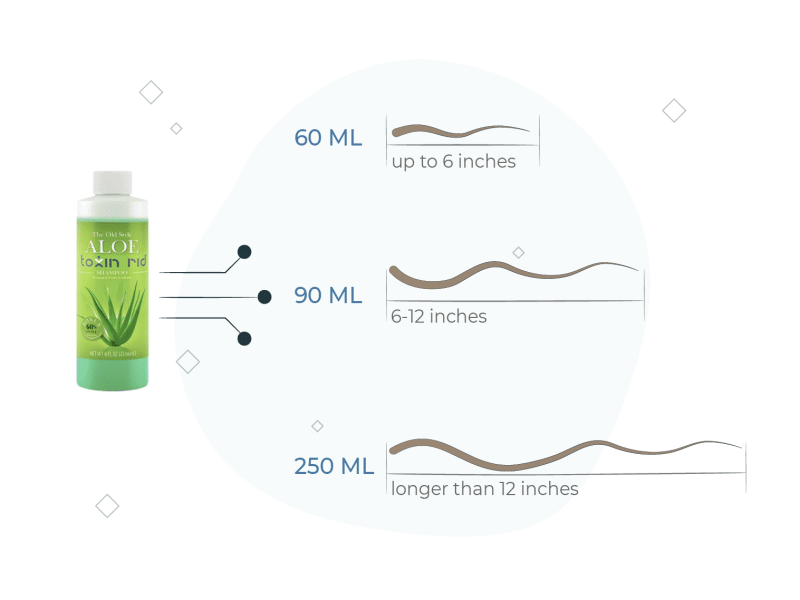
(Image depicts general shampoo amounts based on hair length, not specific recommendations for this product’s effectiveness)
Instead of specific wash counts (which lack scientific backing for guaranteeing results), focus on the process typically recommended:
- Users often report needing multiple washes spread over several days leading up to a potential screening.
- The product’s own labeling should be consulted for the manufacturer’s recommended usage pattern.
Typical Washing Steps:
To use the shampoo according to common advice:
- Preparation: Start the cleansing regimen several days (e.g., 3-10 days) before any anticipated screening, if possible. If time is short, some users attempt multiple washes per day, though scalp sensitivity should be monitored.
- Application Process:
- Begin by washing hair with a regular shampoo to remove surface oils and styling products; rinse well with warm water.
- Apply a standard amount (e.g., dime or quarter-sized, depending on hair length) of Old Style Aloe Toxin Rid Shampoo.
- Massage thoroughly into the hair and, importantly, the scalp. Focus on the roots and scalp area where newer hair growth originates and oils accumulate.
- Let the shampoo sit and lather in the hair for the recommended time, often suggested as 10-15 minutes, to allow potential penetration.
- Rinse very thoroughly with warm water.
- Follow up with a regular conditioner to help restore moisture and manageability, as deep-cleansing shampoos can sometimes be drying.
- Focus: Ensure the shampoo reaches the scalp and the hair closest to it, as this represents the most recent growth.
- Consistency: Following the chosen washing schedule consistently and thoroughly covering all hair during each application is typically emphasized in user instructions.
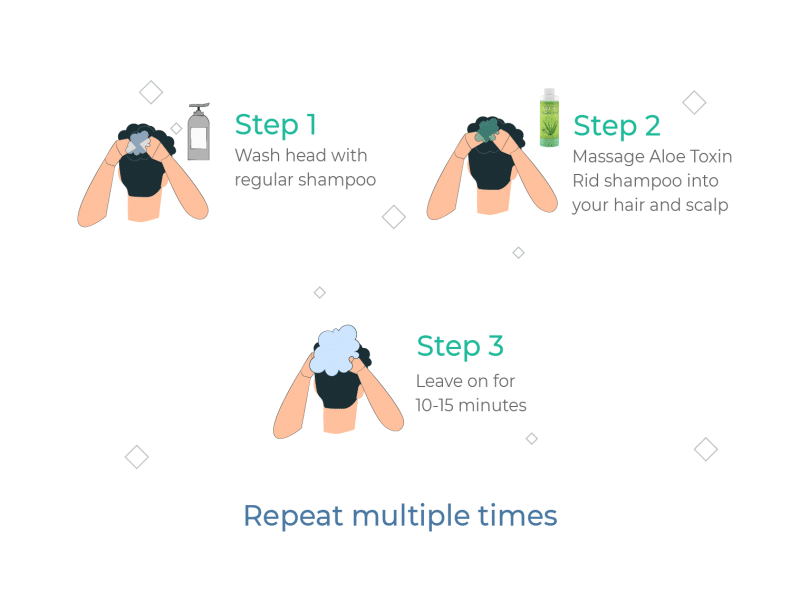
Important Considerations:
- Follow Product Label: Always prioritize the instructions provided on the product packaging.
- No Guarantees: Adhering to these steps does not guarantee a specific outcome in a hair follicle screening. Effectiveness varies, and many factors are involved.
- Plan Accordingly: If choosing to use this product, allow ample time for the suggested washing regimen.
- Monitor Scalp Health: Pay attention to any signs of irritation or dryness and discontinue use if significant discomfort occurs.
- Legal and Ethical Responsibility: Regardless of usage patterns, attempting to interfere with mandatory drug testing remains legally risky and ethically questionable. Abstinence is the only guaranteed method for a substance-free sample.
Where to Buy
To ensure purchase of the authentic Old Style Aloe Toxin Rid Shampoo and avoid potential counterfeits sometimes found on auction sites (like eBay) or informal marketplaces (like Reddit), it’s generally recommended to buy directly from authorized sources.
- Testclear Website: An official retailer for the product.
- Toxin Rid Website: The manufacturer’s official website. (Note: These may be affiliated entities). Purchasing from these sources helps ensure product authenticity.
The product is available through these official channels.
Shipping Information (Provided by Retailer):
- Carriers: Shipping is typically handled via carriers like UPS, FedEx, and USPS.
- Options: Various shipping speeds may be offered (e.g., Ground, 3 Day, 2 Day, Overnight). Service guarantees often apply to the continental US, per carrier policies.
- Cut Off Times: Retailers usually have daily order cutoff times for same-day shipping (e.g., 2 pm Pacific / 5 pm Eastern Time on weekdays). Orders placed after the cutoff or on weekends/holidays typically ship the next business day. Contacting support might be necessary for urgent orders placed near the cutoff.
- Discount Code Note: A discount code “testclear10” is sometimes mentioned online for use at checkout via specific links.
Conclusion
Old Style Aloe Toxin Rid Shampoo is a commercially available hair cleansing product containing ingredients like propylene glycol, which some limited scientific studies suggest may help reduce the concentration of certain drug metabolites in hair under laboratory conditions. It is formulated as a cosmetic shampoo and is generally considered less harsh than aggressive, potentially dangerous DIY chemical methods sometimes discussed online.
However, it is crucial to approach this product and the topic of hair cleansing with significant caution and awareness. There is no reliable scientific evidence guaranteeing that this or any similar shampoo will successfully remove all traces of substances or ensure a negative result in a formal hair follicle screening. Effectiveness can be highly variable based on individual factors (hair type, substance exposure) and testing specifics (cutoff levels).
Furthermore, the legal and ethical implications of attempting to alter or circumvent drug tests, especially those mandated for employment or legal reasons, are serious. Such actions can lead to job loss, legal penalties, and raise ethical concerns. The only certain method to ensure a hair sample accurately reflects non-use of substances is through abstinence.
If considering this product, purchase from authorized retailers to ensure authenticity, be aware of the lack of FDA evaluation for altering test results, follow usage instructions carefully, and understand the limitations and risks involved.
FAQ
How is Old Style Aloe Toxin Rid Shampoo typically used?
General usage guidelines, often based on manufacturer suggestions and user experiences, involve washing the hair multiple times over several days prior to any anticipated screening. A typical process includes washing with regular shampoo, applying Old Style Aloe Toxin Rid (massaging into scalp and hair), letting it sit for 10-15 minutes, rinsing thoroughly, and conditioning. Following the product’s specific label instructions is recommended.
What is the claimed mechanism of Old Style Aloe Toxin Rid Shampoo?
The proposed mechanism centers on its ingredients, particularly propylene glycol (a penetration enhancer) and various surfactants (cleansing agents). The claim is that these components help the shampoo penetrate the hair shaft to loosen and dissolve drug metabolites embedded within the hair’s cortex, making them easier to rinse away. The scientific validation for reliably achieving this in real-world scenarios is limited.
Does Old Style Aloe Toxin Rid Shampoo work equally for all types of drugs?
Effectiveness appears to vary based on the substance. Limited studies suggest potential reductions for metabolites of THC and morphine might be more significant than for cocaine or methamphetamine under specific lab conditions. However, this does not translate to guaranteed effectiveness for “passing” a screening for any specific drug, as initial concentrations and testing cutoffs vary greatly.
Can hair type affect how well Old Style Aloe Toxin Rid Shampoo works?
Yes, hair characteristics likely play a role. Factors like hair thickness, density, porosity, melanin content (darker hair potentially binding substances more strongly), and overall condition can influence how substances are incorporated into the hair and how resistant they might be to removal attempts. Individuals with certain hair types might find cleansing more challenging.
